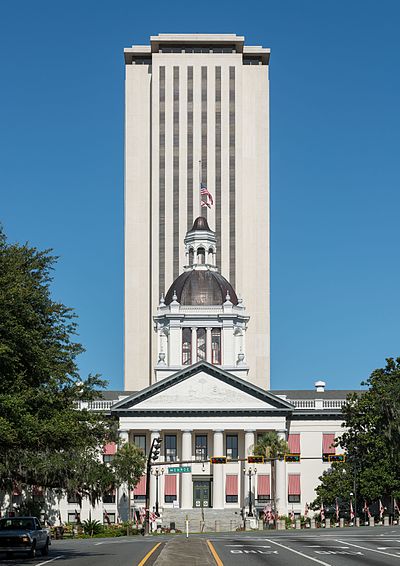
Search
Tallahassee metropolitan area

The Tallahassee metropolitan area is the metropolitan area centered on Tallahassee, the capital of the U.S. state of Florida, in Leon County. It is located in the center of North Florida in the Florida panhandle.
The Tallahassee Metropolitan Statistical Area is a metropolitan statistical area (MSA) designated by the Office of Management and Budget and used by the Census Bureau and other agencies for statistical purposes. The Tallahassee Metropolitan Statistical Area consists of the following four Florida counties: Leon, Gadsden, Wakulla, and Jefferson.
The Tallahassee—Bainbridge, FL-GA Combined Statistical Area is a combined statistical area (CSA) is a primary statistical area that includes the Tallahassee, FL Metropolitan Statistical Area and the Bainbridge, GA Micropolitan Statistical Area (μSA), which consists solely of the Georgia county of Decatur.
Additionally, the Thomasville, GA μSA is immediately adjacent to the Tallahassee MSA to the northeast. The distance and driving time between the Thomasville and Tallahassee city centers during commuting hours is both five miles and 5-10 minutes shorter than those between the Bainbridge and Tallahassee city centers.
*denotes principal city in the MSA
The Tallahassee Standard Metropolitan Statistical Area was first defined in 1965, and at that time included only Leon County. Wakulla County was added to the MSA in 1973. In 1983, Wakulla County was removed from the MSA and Gadsden County was added. Jefferson County and Wakulla County (for the second time) were added to the MSA in 2003.
The counties of the Tallahassee Metropolitan Area cover an area of around 2,604 sq mi (6,750 km2), of which around 2,390 sq mi (6,1890 km2) is land. Much of that water area is in Wakulla and Jefferson counties along the coastline of Apalachee Bay. Only 141.33 sq mi (366.04 km2), or 5.92%, of the area is urbanized, with nearly 80% of said urban area belonging to the Tallahassee, FL Urban Area.
Greater Tallahassee straddles the boundaries of the Red Hills Region, the Cody Scarp, and the Woodville Karst Plain. As such, the northern half of the metropolitan area, including much of the city of Tallahassee, is substantially more hilly than the rest of the state of Florida. The area also straddles four watersheds, from west to east: Apalachicola, Ochlockonee, St. Marks, and Aucilla. The latter three all drain into the Gulf of Mexico either within or at the edges of the metropolitan area, with the Ocholockonee and Aucilla Rivers forming parts of the western and eastern borders.
Also see Leon County Geology
All counties in both the Tallahassee MSA and CSA are in Eastern Time Zone, with the western border of Gadsden County with Jackson County forming the boundary with the Central Time Zone.
As of the census of 2000, there were 320,304 people, 125,533 households, and 75,306 families residing within the MSA. The racial makeup of the MSA was 63.59% White, 32.17% African American, and 1.39% from two or more races. 3.72% were Hispanic or Latino of any race.
The median income for a household in the MSA was $34,728, and the median income for a family was $42,957. Males had a median income of $29,628 versus $24,977 for females. The per capita income for the MSA was $17,552.
Also see Tallahassee Places of interest and Arts and Culture.
- Alfred B. Maclay Gardens State Park
- Apalachicola National Forest
- DeSoto Site Historic State Park
- Edward Ball Wakulla Springs State Park
- Elinor Klapp-Phipps Park
- Lake Jackson Mounds Archaeological State Park
- Lake Talquin State Forest and Park
- Letchworth-Love Mounds Archaeological State Park
- Miccosukee Canopy Road Greenway
- Natural Bridge Battlefield Historic State Park
- Ochlockonee River State Park
- San Marcos de Apalache Historic State Park
- St. Marks National Wildlife Refuge
- St. Marks River Preserve State Park
- Wakulla State Forest
The Tallahassee Metropolitan Area has contains eight incorporated cities and two incorporated towns, along with thirteen additional populated areas defined as a census-designated place (CDP) by the U.S. Census Bureau as of the 2020 census. The Combined Statistical Area has an additional three cities, one town, and one CDP. As of 2020, the city of Tallahassee contained 51% and 47% of the MSA and CSA populations, respectively.
*denotes largest city and county chair
- Florida statistical areas
- Metropolitan and Micropolitan Statistical Area Definitions - retrieved July 17, 2006
Text submitted to CC-BY-SA license. Source: Tallahassee metropolitan area by Wikipedia (Historical)
Articles connexes
- Tallahassee, Florida
- St. Marks, Florida
- Metropolitan statistical area
- Leon County, Florida
- Wakulla County, Florida
- U.S. Route 27 in Florida
- Crawfordville, Florida
- Quincy, Florida
- Sopchoppy, Florida
- Havana, Florida
- Gadsden County, Florida
- Monticello, Florida
- Tallahassee International Airport
- Walkatomica
- Mashes Sands
- Tornado outbreak of May 6–10, 2024
- Scotland, Florida
- Scottown, Florida
- List of metropolitan areas of Florida
- Shadeville, Florida
Owlapps.net - since 2012 - Les chouettes applications du hibou


